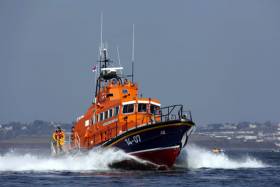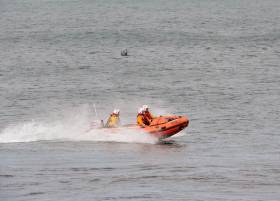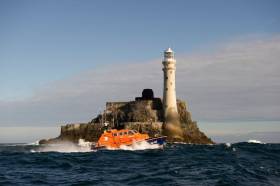Displaying items by tag: Lifeboats
Engine Failure On West Cork Fishing Trip Vessel Prompts Courtmacsherry Lifeboat Rescue
#RNLI - Courtmacsherry RNLI’s all-weather lifeboat was called out at 4.20pm yesterday afternoon (Tuesday 1 August) to go to the aid of a 40ft pleasure fishing boat with mechanical failure 15 miles off the Seven Heads in West Cork.
The Courtmacsherry Lifeboat, under coxswain Kevin Young and with a crew of six, launched in minutes and reached the stricken boat just after 5pm.
On scene near the Lusitania site, the lifeboat secured a tow line to the vessel and then proceeded to tow it back to the safe haven of Courtmacsherry’s inner harbour.
All six on the pleasure boat were safely returned to Courtmacsherry Pontoon at 8pm.
Weather conditions on the callout reasonable, with winds in the area blowing Force 3-4.
The callout was the latest in what was a busy 48 hours for the voluntary crew of Courtmacsherry RNLI, with three callouts to boats in distress beginning on Sunday afternoon with the rescue of another pleasure fishing boat, as previously reported on Afloat.ie.
Rosslare Harbour Lifeboat In Extensive Search For Swimmer Reportedly Swept Out To Sea
#RNLI - Rosslare Harbour RNLI was involved in an extensive search off the Wexford coast yesterday (Tuesday 1 August) after a swimmer was reported to have been swept out to sea.
The alarm was raised shortly after 3pm by a member of the public who reported what they thought to be a swimmer being carried out to sea from Rosslare Strand.
The all-weather lifeboat, under coxswain Eamonn O’Rourke, launched at 3.15pm and began an extensive search. The Irish Coast Guard helicopter Rescue 117 from Waterford was also tasked.
Weather conditions were good for searching, with a south west Force 4 wind blowing.
Following a four-hour search, the volunteer crew were requested to stand down the lifeboat at 7.30pm, with no one reported missing and no one found.
Speaking following the callout, Rosslare Harbour RNLI lifeboat press officer Jamie Ryan said: “We would like to commend the member of the public who raised the alarm today. That is the right thing to do if you think someone has got into difficulty on the water.”
#RNLI - Baltimore RNLI completed a busy weekend when the inshore lifeboat was launched on Sunday afternoon (30 July) to a report of an upturned vessel off Heir Island.
The volunteer lifeboat launched at 2.42pm arrived on scene to find a rigged Laser sailing boat, with no occupants, on the shore.
Baltimore’s RNLI crew conducted a sweep around the location of the vessel as other boats in the area, as well as the Irish Coast Guard helicopter from Waterford, joined in the search.
Conditions at the time were calm, with Force 3 to 4 winds and good visibility.
Within an hour, reports came in to the coastguard that the boat had got caught up on a static mooring while sailing earlier that morning. Unable to free the vessel, the sailor made their own way ashore, leaving the sailing boat fully rigged and stuck on the mooring.
Some time later the boat came off the mooring by itself and came ashore on its side, prompting a member of the public to raise the alarm when they came across it.
“We are delighted that there was a good outcome with this situation,” said Gerald O’Brien, Baltimore RNLI volunteer deputy launching authority.
“Always remember, if you get into difficulty at sea or witness a vessel in trouble from the shoreline, call 999 or 112 and ask for the coastguard.”
Baltimore RNLI previously launched twice on Friday (28 July) on two separate callouts, involving a Drascombe Lugger in distress and an emergency beacon activated on an offshore yacht, respectively.
Baltimore Lifeboat Responds To Drascombe Lugger Mayday
#RNLI - Just hours after launching to an alarm from a yacht’s emergency beacon on Friday morning (28 July), Baltimore RNLI’s all-weather lifeboat was back in action responding to a Mayday from a Drascombe Lugger taking on water in Schull Harbour.
The lifeboat launched at 6.11pm and proceeded to the scene amid calm conditions at sea, with a westerly Force 4 wind and good visibility.
Before they arrived, however, Schull Coast Guard’s inshore rescue boat was first on scene six minutes later and took the sailing boat with two on board under tow back to Schull Harbour.
“The sailors did the right thing this evening and raised the alarm when they found themselves in difficulty,” said Kate Callanan, Baltimore RNLI volunteer lifeboat press officer.
“We would like to commend our colleagues in the Irish Coast Guard who arrived on scene and brought the vessel to safety.”
#Rescue - A mother and her two children were rescued from a sea cave at Silver Strand yesterday afternoon (Saturday 29 July) in a joint operation between Wicklow RNLI and the Irish Coast Guard.
The two children had got into difficulty while swimming at the popular beach south of Wicklow Head, and their mother rushed to their aid – only for the three of them to be swept into a nearby cave.
Wicklow RNLI’s inshore lifeboat was launched at 4.40pm and arrived on scene with the Dublin-based coastguard helicopter Rescue 116, which lowered a winchman onto the beach to locate the casualties.
The Wicklow lifeboat followed shortly after, and helm Graham Fitzgerald brought the rescue vessel close to shore where the lifeboat crew spotted three people and the winchman in a cave.
Weather conditions in the area were windy, with a southerly Force 4 and high breaking surf at the mouth of the cave.
After an assessment by the winchman and lifeboat helm, it was decided that the winchman would lead the casualties to the adjoining cave, as rocks at the entrance would impede getting the boat close to shore.
Once the casualties were in the other cave, the lifeboat crew brought the boat onto the beach and all three were transferred to the lifeboat along with the coastguard winchman.
The mother and her two daughters were believed to have been on a day trip to the beach when they decided to go for a swim and one of them got into difficultly. Her sister had tried to help, but also got into trouble.
The mother then entered the water to help her daughters, which resulted in all three of them ending up in the cave.
The winchman, a trained paramedic, assessed the three casualties on the lifeboat and they were brought to Wicklow Harbour, where they were given hot drinks.
Wicklow RNLI were involved in a similar rescue at Silver Stand in 2014 when the lifeboat was called out to rescue a woman who had been swept into a cave after getting into difficulty swimming.
#RNLI - Baltimore RNLI launched this morning (Friday 28 July) to locate a vessel sending an alarm from their positioning beacon off the coast of West Cork.
The Irish Coast Guard requested the launch just before 10am after it had picked up an alarm from an EPIRB (electronic position indication radio beacon) on a yacht half a mile south west of Cape Clear Island.
Coastguard staff at Mizen Head had no success raising the occupants of the yacht on their VHF so the Baltimore all-weather lifeboat was launched to investigate at the last known co-ordinates of the vessel.
Meanwhile, 10.30am the coastguard finally made contact with the yacht’s two occupants on their VHF and established that the EPIRB had been activated by accident.
Speaking after the callout, Baltimore RNLI volunteer lifeboat navigator Micheal Cottrell said: “It is important to ensure the secure fastening of an EPIRB on board a vessel and to regularly check that it is in good working order. Also, whilst out at sea it is important to keep radio watch on Channel 16.
“If you get into difficulty at sea, call 999 or 112 and ask for the coastguard.”
#RNLI - Lough Derg RNLI’s volunteers were surprised to find a man whose cruiser had grounded near Hare Island had spent the night alone stranded in the lake as he was reluctant to call for help.
Valentia Coast Guard requested Lough Derg RNLI to investigate a report from a passing cruiser this morning (Friday 28 July) of a vessel, thought to have slipped its moorings, that was aground behind Hare Island.
At 9.15am the lifeboat crew located the 16ft cruiser in Church Bay, behind Hare Island on the Clare shore. Church Bay is known for particular hazards such as sudden shallows and rocks.
The lifeboat proceeded with caution and, when sufficiently close to the cruiser, an RNLI volunteer waded to the vessel – where a man was found on board, asleep in the cabin below.
Within half an hour the boat was off the rocks and taken under tow to the harbour at Garrykennedy.
Its skipper, who was safe and unharmed and wearing his lifejacket, told the lifeboat crew that he had been stranded on his boat since 8pm the previous evening, but was reluctant to call the rescue services, anxious not to put anyone out.
Winds overnight on Lough Derg were strong westerlies blowing Force 5 and gusting up to Force 7.
“No callout is routine — our training and experience tells us to expect the unexpected,” said Lough Derg RNLI helm Eleanor Hooker.
“We approached what we thought was an empty vessel which had slipped its moorings and found a person onboard who had spent the night alone, stranded in stormy conditions, and without help coming for them.
“The RNLI are there to answer any call for help. No lifeboat launch is ever a waste of our time or resources.”
Pat Garland, deputy launching authority with Lough Derg RNLI, added: “I would urge all boat users when is difficulty to call 999 or 112 and ask for the coastguard.
“RNLI lifeboats are launched at the request of the Irish Coast Guard, who then make the correct call on which search and rescue assets to deploy to the scene.
“We would urge the public not to delay calling for help. This could have had a very different outcome.”
#RNLI - Newcastle RNLI volunteer crews were woken by their pagers at 3.34am yesterday morning (Wednesday 26 July) after a lone yachtsman ran aground at the mouth of Ardglass Marina in Co Down.
The all-weather lifeboat Eleanor and Bryant Girling was on the way by 3.55am and arrived on scene with the casualty vessel 45 minutes later.
The lifeboat crew found the yacht hard aground and listing heavily to starboard on the breakwater protecting the marina.
Under command of coxswain William Chambers, the RNLI crew tried manoeuvring their lifeboat close to the yacht only to find the tide had fallen too much and was too far away to retrieve the lone sailor from his vessel.
With full co-ordination between the RNLI and Newcastle Coastguard on the shore, the lifeboat pulled back to deeper water and provided safety cover while members of the coastguard team carried out a rescue from the shore.
The casualty was removed from the vessel for his own safety with no injuries, and with everyone accounted for the lifeboat was stood down.
#RNLI - Clifden RNLI launched their inshore and all-weather lifeboats on Tuesday night (27 July) to reports of a pleasure boat in difficulty east of Davillaun Island.
The eight people on board had been to Inishbofin for the day and were returning home when the weather turned, becoming wet and foggy.
The volunteer lifeboat crew was requested to launch by Malin Head Coast Guard at 6.58pm to assist the broken down pleasure craft.
Once the Atlantic 85 inshore lifeboat was on scene, one of the RNLI crew boarded the pleasure boat to assist the casualties and to secure a tow line.
Four of the casualties were then transferred onto the lifeboat where they received casualty care while the remaining four people stayed on the pleasure boat as it was towed towards the pier at Aughris, over an hour away.
When the Mersey class all-weather lifeboat arrived, all eight casualties were put on board and taken inside to warm up. The RNLI crew also radioed ahead to request an ambulance to meet them at Aughris as one of the group required further medical attention.
The casualty was assessed by paramedics and transferred to hospital for further treatment. The remaining seven people disembarked the lifeboat at the pier.
“This callout shows how conditions can change quite quickly at sea,” said Clifden RNLI lifeboat helm Daniel Whelan. “Visibility became poor as the weather deteriorated. Thankfully we have a fast responding Atlantic 85 lifeboat and a well-trained crew. Having the all-weather lifeboat provide cover was invaluable, providing warmth and comfort for the casualties.
“Safety at sea is so important. Wear plenty of layers. Tell someone your plan and bring a suitable form of communication. The group in trouble did all of this which made it much easier to locate them.”
Clifden RNLI coxswain David Barry added: “This was a very successful callout with both lifeboat crew working well together to bring the casualties to safety. It was a beautiful day but the weather turned as the evening approached. We wish the patient a speedy recovery.”
#RNLI - Union Hall RNLI were alerted by Valentia Coast Guard at 3.24pm yesterday (Saturday 22) to a report of a 30ft yacht with two sailors gone aground at the middle danger in Glandore Harbour, West Cork.
The lifeboat launched and was underway to the yacht at 3.33pm in favourable weather conditions, with a slight breeze from the north.
While en route to the scene, a member of the public notified the lifeboat station that the yacht had refloated safely. The volunteer crew subsequently spoke to the sailors, who were happy to continue sailing.
Union Hall RNLI deputy launch authority Peter Deasy said: “While a lot of activity is taking place in Glandore Harbour this week with the Glandore Classic Boat Regatta, we advise people to be alert, obey navigation aids and respect the water. If you see someone in trouble dial 999/112 and ask for the coastguard.”







































































